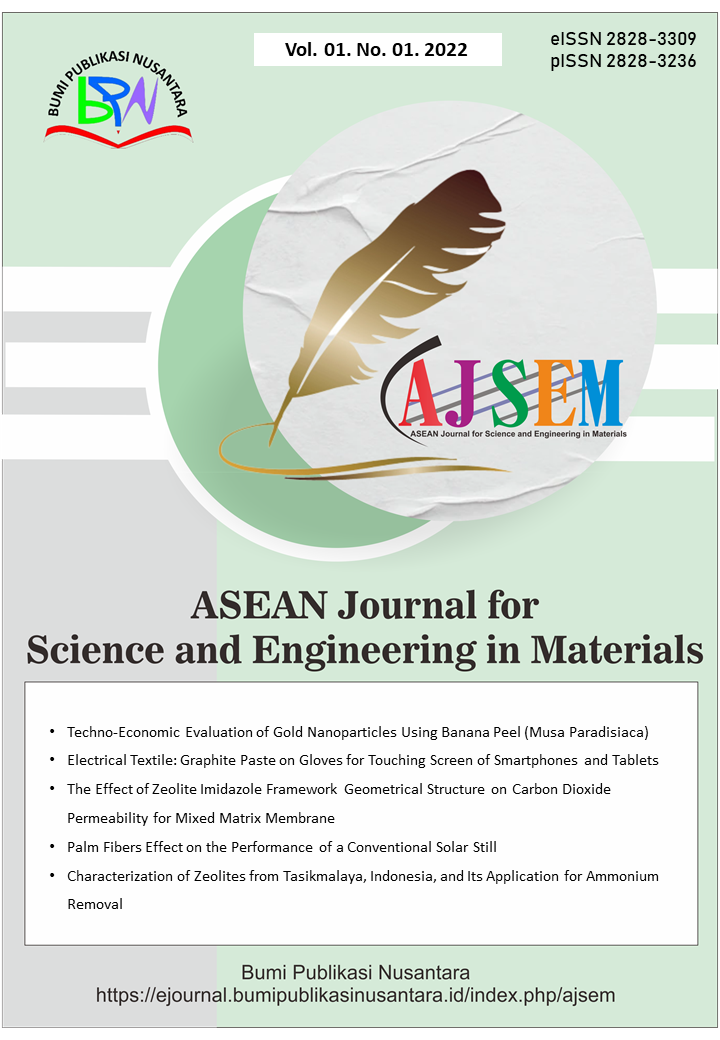Fabrication of Synthetic Lumbar Vertebrae by a Combination of FDM 3D-Printing and PU Foam Casting from Two Injection Techniques for Surgical Training
 ), Nisa Khoiriyah(2), A. Asriyanti(3), Muhammad Satrio Utomo(4), Kushendarsyah Saptaji(5), Nikolas Krisma Hadi Fernandez(6), Muhammad Akhsin Muflikhun(7),
), Nisa Khoiriyah(2), A. Asriyanti(3), Muhammad Satrio Utomo(4), Kushendarsyah Saptaji(5), Nikolas Krisma Hadi Fernandez(6), Muhammad Akhsin Muflikhun(7),
(1) Sampoerna University
(2) Sampoerna University
(3) Sampoerna University
(4) University of Melbourne
(5) Sampoerna University
(6) Sampoerna University
(7) Universitas Gajah Mada
 Corresponding Author
Corresponding Author
Abstract
Keywords
References
Akbaş, O. E., Hıra, O., Hervan, S. Z., Samankan, S., and Altınkaynak, A. (2020). Dimensional accuracy of FDM-printed polymer parts. Rapid Prototyping Journal, 26(2), 288-298.
Alafaghani, A. A., Qattawi, A., Alrawi, B., and Guzman, A. (2017). Experimental optimization of fused deposition modelling processing parameters: a design-for-manufacturing approach. Procedia Manufacturing, 10, 791-803.
Al-Atroush, M. E., and Sebaey, T. A. (2021). Stabilization of expansive soil using hydrophobic polyurethane foam: A review. Transportation Geotechnics, 27, 100494.
Alsoufi, M. S., Alhazmi, M. W., Suker, D. K., Alghamdi, T. A., Sabbagh, R. A., Felemban, M. A., and Bazuhair, F. K. (2019). Experimental characterization of the influence of nozzle temperature in FDM 3D printed pure PLA and advanced PLA+. American Journal of Mechanical Engineering, 7(2), 45-60.
Asriyanti, A., Saptaji, K., Khoiriyah, N., Utomo, M. S., Dwijaya, M. S., Triawan, F., and Nadhif, M. H. (2022). Fabrication of rigid polyurethane foam lumbar spine model for surgical training using indirect additive manufacturing. International Journal of Technology, 13, 1612.
Atesok, K., Mabrey, J. D., Jazrawi, L. M., and Egol, K. A. (2012). Surgical simulation in orthopaedic skills training. JAAOS-Journal of the American Academy of Orthopaedic Surgeons, 20(7), 410-422.
Blair-Pattison, A. (2016). Development and characterization of a synthetic bone analogue for surgical training. Development, 2016, 01-18.
Bohl, M. A., Zhou, J. J., Mooney, M. A., Repp, G. J., Cavallo, C., Nakaji, P., and Kakarla, U. K. (2019). The Barrow Biomimetic Spine: effect of a 3-dimensional-printed spinal osteotomy model on performance of spinal osteotomies by medical students and interns. Journal of Spine Surgery, 5(1), 58.
Brown, A. D., Walters, J. B., Zhang, Y. X., Saadatfar, M., Escobedo-Diaz, J. P., and Hazell, P. J. (2019). The mechanical response of commercially available bone simulants for quasi-static and dynamic loading. Journal of the Mechanical Behavior of Biomedical Materials, 90, 404-416.
Clifton, W., Nottmeier, E., Damon, A., Dove, C., Chen, S. G., Pichelmann, M., & Chen, S. (2019). A feasibility study for the production of three-dimensional-printed spine models using simultaneously extruded thermoplastic polymers. Cureus, 11(4), 1-6.
Clifton, W., Pichelmann, M., Vlasak, A., Damon, A., ReFaey, K., and Nottmeier, E. (2020). Investigation and feasibility of combined 3D printed thermoplastic filament and polymeric foam to simulate the cortiocancellous interface of human vertebrae. Scientific Reports, 10(1), 2912.
Ergene, B., ŞEKEROĞLU, İ., Bolat, Ç., and Yalçın, B. (2021). An experimental investigation on mechanical performances of 3D printed lightweight ABS pipes with different cellular wall thickness. Journal of Mechanical Engineering and Sciences, 15(2), 8169-8177.
Frost, B. A., Camarero-Espinosa, S., and Foster, E. J. (2019). Materials for the spine: anatomy, problems, and solutions. Materials, 12(2), 253.
Galbusera, F., and Bassani, T. (2019). The spine: a strong, stable, and flexible structure with biomimetics potential. Biomimetics, 4(3), 60.
Garg, B., and Mehta, N. (2018). Current status of 3D printing in spine surgery. Journal of Clinical Orthopaedics and Trauma, 9(3), 218-225.
Geier, S., Winkler, C., and Piesche, M. (2009). Numerical simulation of mold filling processes with polyurethane foams. Chemical Engineering & Technology: Industrial Chemistry‐Plant Equipment‐Process Engineering‐Biotechnology, 32(9), 1438-1447.
Gerhardt, L. C., and Boccaccini, A. R. (2010). Bioactive glass and glass-ceramic scaffolds for bone tissue engineering. Materials, 3(7), 3867-3910.
Ghomi, E. R., Khosravi, F., Neisiany, R. E., Singh, S., and Ramakrishna, S. (2021). Future of additive manufacturing in healthcare. Current Opinion in Biomedical Engineering, 17, 100255.
Hatchett, D. W., Kinyanjui, J. M., and Sapochak, L. (2007). FTIR analysis of chemical gradients in thermally processed molded polyurethane foam. Journal of Cellular Plastics, 43(3), 183-196.
Heiner, A. D., and Brown, T. D. (2001). Structural properties of a new design of composite replicate femurs and tibias. Journal of Biomechanics, 34(6), 773-781.
Houben, A., Van Hoorick, J., Van Erps, J., Thienpont, H., Van Vlierberghe, S., and Dubruel, P. (2017). Indirect rapid prototyping: opening up unprecedented opportunities in scaffold design and applications. Annals of Biomedical Engineering, 45, 58-83.
Husemoglu, R. B., Baysan, G., Ertugruloglu, P., Yücel, A. T., and Havıtçıoğlu, H. (2020). The mechanical comparison of artificial bone and 3D printed bone segments. Journal of Medical Innovation and Technology, 2(2), 127-130.
Jackovich, D., O'toole, B., Hawkins, M. C., and Sapochak, L. (2005). Temperature and mold size effects on physical and mechanical properties of a polyurethane foam. Journal of Cellular Plastics, 41(2), 153-168.
Kang, S. W., Yang, H. S., Seo, S. W., Han, D. K., and Kim, B. S. (2008). Apatite‐coated poly (lactic‐co‐glycolic acid) microspheres as an injectable scaffold for bone tissue engineering. Journal of Biomedical Materials Research Part A, 85(3), 747-756.
La Nasa, J., Biale, G., Ferriani, B., Colombini, M. P., and Modugno, F. (2018). A pyrolysis approach for characterizing and assessing degradation of polyurethane foam in cultural heritage objects. Journal of Analytical and Applied Pyrolysis, 134, 562-572.
Lee, W. H., Lee, S. W., Kang, T. J., Chung, K., and Youn, J. R. (2002). Processing of polyurethane/polystyrene hybrid foam and numerical simulation. Fibers and Polymers, 3, 159-168.
Liu, G., Liao, H., Zhao, X., Liao, W. H., and Cao, J. (2024). Haptic device and interface to reproduce force and tactile feedback of biological tissues. Sensors and Actuators A: Physical, 366, 115022.
Liu, W., Zhang, S., Li, Y., and Ye, X. (2023). The expansion and mechanical property-based cavity expansion model for polyurethane grouting underneath the airport pavement. Transportation Geotechnics, 43, 101141.
Lughmani, W. A., Bouazza-Marouf, K., and Ashcroft, I. (2015). Drilling in cortical bone: a finite element model and experimental investigations. Journal of The Mechanical Behavior of Biomedical Materials, 42, 32-42.
Moles, J. J., Connelly, P. E., Sarti, E. E., and Baredes, S. (2009). Establishing a training program for residents in robotic surgery. The Laryngoscope, 119(10), 1927-1931.
Morgan, E. F., Unnikrisnan, G. U., and Hussein, A. I. (2018). Bone mechanical properties in healthy and diseased states. Annual review of Biomedical Engineering, 20(1), 119-143.
Nery, B., Rivero, L. R., Camporeze, B., Costa, R. A. F., Pereira, L. C., Quaggio, E., and Nery, C. S. A. (2021). Use of three-dimensional reconstruction in 3D molds as an adjuvant in the treatment of cranial and spinal pathologies: technical details and case report. Interdisciplinary Neurosurgery, 24, 100953.
Öhman‐Mägi, C., Holub, O., Wu, D., Hall, R. M., and Persson, C. (2021). Density and mechanical properties of vertebral trabecular bone—A review. JOR Spine, 4(4), e1176.
Özdemir, İ. B., and Akar, F. (2018). 3D simulation of polyurethane foam injection and reacting mold flow in a complex geometry. Heat and Mass Transfer, 54(5), 1281-1288.
Parsons, N. S., and Mountain, C. A. (2007). Investigating polyurethane foam as a form of trace evidence. Science & Justice, 47(1), 24-33.
Ravindra, V. M., Senglaub, S. S., Rattani, A., Dewan, M. C., Härtl, R., Bisson, E., and Shrime, M. G. (2018). Degenerative lumbar spine disease: estimating global incidence and worldwide volume. Global Spine Journal, 8(8), 784-794.
Reid, P. C., Morr, S., and Kaiser, M. G. (2019). State of the union: a review of lumbar fusion indications and techniques for degenerative spine disease: JNSPG 75th Anniversary Invited Review Article. Journal of Neurosurgery: Spine, 31(1), 1-14.
Rizvi, A., Chu, R. K., and Park, C. B. (2018). Scalable fabrication of thermally insulating mechanically resilient hierarchically porous polymer foams. ACS Applied Materials & Interfaces, 10(44), 38410-38417.
Ruikar, D. D., Hegadi, R. S., and Santosh, K. C. (2018). A systematic review on orthopedic simulators for psycho-motor skill and surgical procedure training. Journal of Medical Systems, 42, 1-21.
Saad, W. A., Dzahir, M. A. M., Shinichirou, Y., Hussein, M., Mohamad, M., Saad, S. M., and Azaman, A. (2020). Comparison of the spine kinematics by defining lumbar as single and multi-segmental in completing critical daily task. Journal of Mechanical Engineering and Sciences, 14(4), 7600-7608.
Samkhaniani, N., Gharehbaghi, A., and Ahmadi, Z. (2013). Numerical simulation of reaction injection molding with polyurethane foam. Journal of Cellular Plastics, 49(5), 405-421.
Schäfer, K., Nestler, D., Tröltzsch, J., Ireka, I., Niedziela, D., Steiner, K., and Kroll, L. (2020). Numerical studies of the viscosity of reacting polyurethane foam with experimental validation. Polymers, 12(1), 105.
Seehanam, S., Khrueaduangkham, S., Sinthuvanich, C., Sae-Ueng, U., Srimaneepong, V., and Promoppatum, P. (2024). Evaluating the effect of pore size for 3d-printed bone scaffolds. Heliyon, 10(4), e26005.
Senra, M. R., and Marques, M. D. F. V. (2020). Synthetic polymeric materials for bone replacement. Journal of Composites Science, 4(4), 191.
Shull, P. B., and Damian, D. D. (2015). Haptic wearables as sensory replacement, sensory augmentation and trainer–a review. Journal of Neuroengineering and Rehabilitation, 12, 1-13.
Sparrey, C. J., Bailey, J. F., Safaee, M., Clark, A. J., Lafage, V., Schwab, F., and Ames, C. P. (2014). Etiology of lumbar lordosis and its pathophysiology: a review of the evolution of lumbar lordosis, and the mechanics and biology of lumbar degeneration. Neurosurgical Focus, 36(5), E1.
Sun, M., Bi, Y., Zhuang, W., Chen, S., Zhao, P., Pang, D., and Zhang, W. (2021). Mechanism of polyurethane binder curing reaction and evaluation of polyurethane mixture properties. Coatings, 11(12), 1454.
Syahrom, A., Kadir, M. R. A., Harun, M. N., and Öchsner, A. (2015). Permeability study of cancellous bone and its idealised structures. Medical Engineering & Physics, 37(1), 77-86.
Teraguchi, M., Yoshimura, N., Hashizume, H., Muraki, S., Yamada, H., Minamide, A., and Yoshida, M. (2014). Prevalence and distribution of intervertebral disc degeneration over the entire spine in a population-based cohort: the Wakayama Spine Study. Osteoarthritis and Cartilage, 22(1), 104-110.
Wang, T. M., Lin, Y. C., Lan, Y. H., and Lin, L. D. (2022). Evaluation of sawbones training protocol in bone quality classification using tactile sensation. Journal of Dental Sciences, 17(2), 897-902.
Zhang, H., Wang, R., Song, Y., Wang, Y., and Hu, Q. (2024). Research on dual-phase composite forming process and platform construction of radial gradient long bone scaffold. Bioengineering, 11(9), 869.
Zharylkassyn, B., Perveen, A., and Talamona, D. (2021). Effect of process parameters and materials on the dimensional accuracy of FDM parts. Materials Today: Proceedings, 44, 1307-1311.
Article Metrics
Abstract View : 361 times
: 361 times Download : 174 times
Download : 174 times
Refbacks
- There are currently no refbacks.
Copyright (c) 2025 Bumi Publikasi Nusantara

This work is licensed under a Creative Commons Attribution-ShareAlike 4.0 International License.









